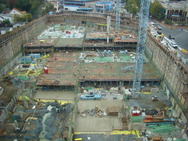If Maryland kills the Purple Line, it’s asking for a $650 million parking bill

Bethesda’s $64,000-per-space garage under construction. Photo by author.
If Governor-elect Larry Hogan chooses not to build the Purple Line, he will sock Maryland taxpayers, commuters, and businesses with a huge bill they don’t expect. Building parking garages for drivers who would otherwise take the train would likely cost over $600 million, much of it public money.
Parking is expensive, and in the built-up areas where the Purple Line would run, there’s no empty land; new spaces would have to go in garages above or below ground.
If there’s no Purple Line, more people will leave home in cars, and more parking will be needed at their destinations:
- Purple Line planners predict that people will take 9,850 new trips on the train that start from their homes. Altogether, they forecast the Purple Line attracting over 29,000 new one-way transit trips each day.
- With an average of 1.1 passengers per car, canceling the light rail line will create a need for 8,955 additional parking spaces at whatever destination people making home-based trips arrive at.
- 3,018 of these trips will terminate in downtown Bethesda and Silver Spring, where new parking has to go underground. 4,796 will end elswhere in the inner suburbs, where above-ground garages are the norm.
Montgomery County is now paying $64,000 per space for an underground garage and $53,000 per new space for a parking structure. At these prices, the cost of this destination parking will be $447 million. This does not include parking for people who travel to D.C. or Virginia, or the value of land used for parking lots in outer Maryland suburbs.
Without the Purple Line, downtown residents and students would need more parking space
Cars have to go somewhere at the end of their trips too. The Purple Line won’t cut the cost of parking at single-family homes, but apartments and dormitories will need more parking without it.
A rough estimate is that two thirds of the 2,479 new transit riders who live in Bethesda and Silver Spring will live in downtown apartments, and of them, half won’t own cars if they don’t drive to work. If the Purple Line doesn’t go in, new apartment buildings will need more underground spaces, at a cost of $48 million.
Students are not included in the planners’ count of home-based trips. University of Maryland administrators expect the Purple Line to greatly improve transit access, and they need to use space currently occupied by parking lots to expand the school itself. As such, they have decided to ban on-campus parking by resident students. The ban will eliminate the need for 2,889 parking spaces, but it’s unlikely to go into effect without the Purple Line. If the Purple Line goes, Maryland will need a new parking garage— an expenditure we can estimate at $153 million.
The parking spaces all these drivers will need are going to cost a lot
The cost of all these garages adds up to $648 million. Government funds will pay for parking for University of Maryland employees and students and public garages in Bethesda and Silver Spring. These could add up to as much as half the total.
The remaining cost of the Purple Line for Maryland and its counties, after subtracting federal aid and money already spent, is $1.3 billion. If Maryland shortsightedly cancels this project, the state wouldn’t just throw away immense benefits in livability and economic development. It would see half of the supposed cost savings vanish into parking garages.
Clarification: The original version of this post listed 9,850 as a number of trips that start from home on the Purple Line. This is the number of new transit trips (trips that would otherwise be taken by car) that start from home, not the total number of home-based trips on the line.

